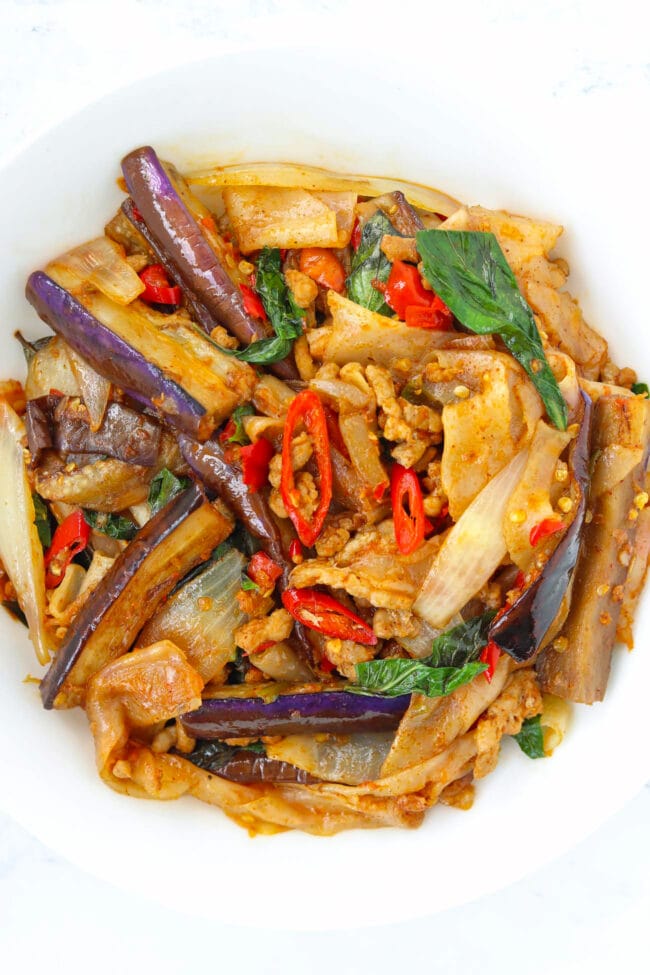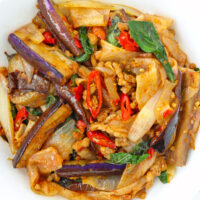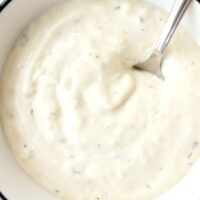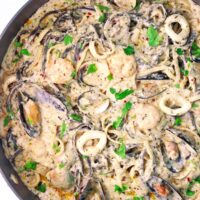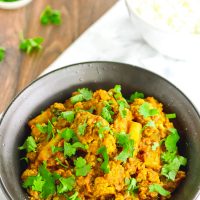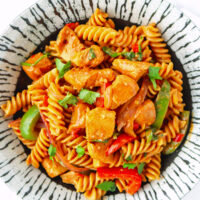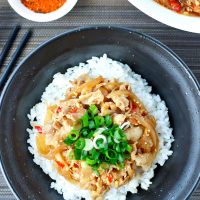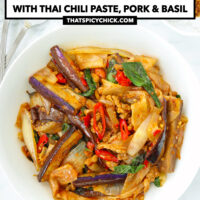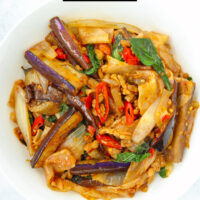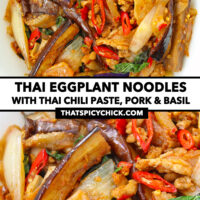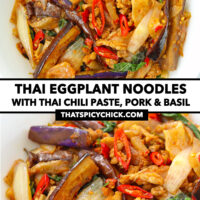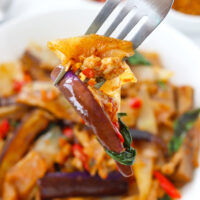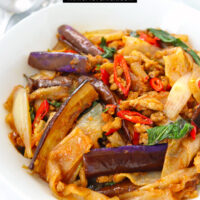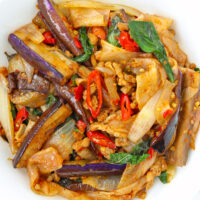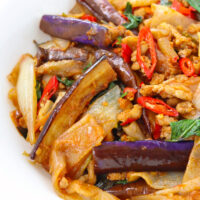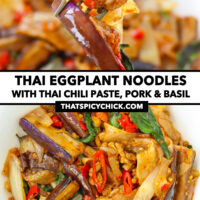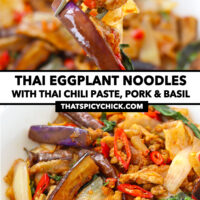Thai Eggplant Noodles
This post contains affiliate links.
This Thai Eggplant Noodles is quick and easy to make in 30 minutes and full of the BEST salty, spicy, sweet and tangy flavors! Juicy eggplant strips, ground pork, garlic, chilies, and fragrant Thai sweet basil get tossed with fresh flat wide rice noodles in a mouthwatering sauce starring Thai chili paste (Nam Prik Pao)! It’s customizable with your favorite protein, and gluten-free and vegetarian/vegan adaptable.
Friends, if you’ve tried my Thai Eggplant Stir-fry, you know it is AMAZING and super tasty! It’s a recipe I make very often because I can’t get enough of all the delicious flavors and textures it boasts. If you haven’t tried it, please do – it’s downright heavenly with a bowl of steamed rice!
I was just about to cook it again the other night for dinner, but then an idea struck me. That idea was this Thai Eggplant Noodles! 🎇
This quick and easy noodles stir-fry is made with delicious juicy eggplant strips, ground pork, LOTS of garlic and fresh chilies (though you can use less chilies for a milder dish 👌), and chewy and bouncy fresh flat wide rice noodles! It has all the same beautiful salty, sweet, spicy, and tangy flavors and is incredibly vibrant. The hit of Thai sweet basil leaves at the end rounds out the flavors with fragrant aromas and licorice and anise notes.
If you’re looking for an easy and flavorful Thai noodles stir-fry that is not pad thai or pad kee mao (drunken noodles), give this Thai Eggplant Noodles a try. I think you’re going to love it!
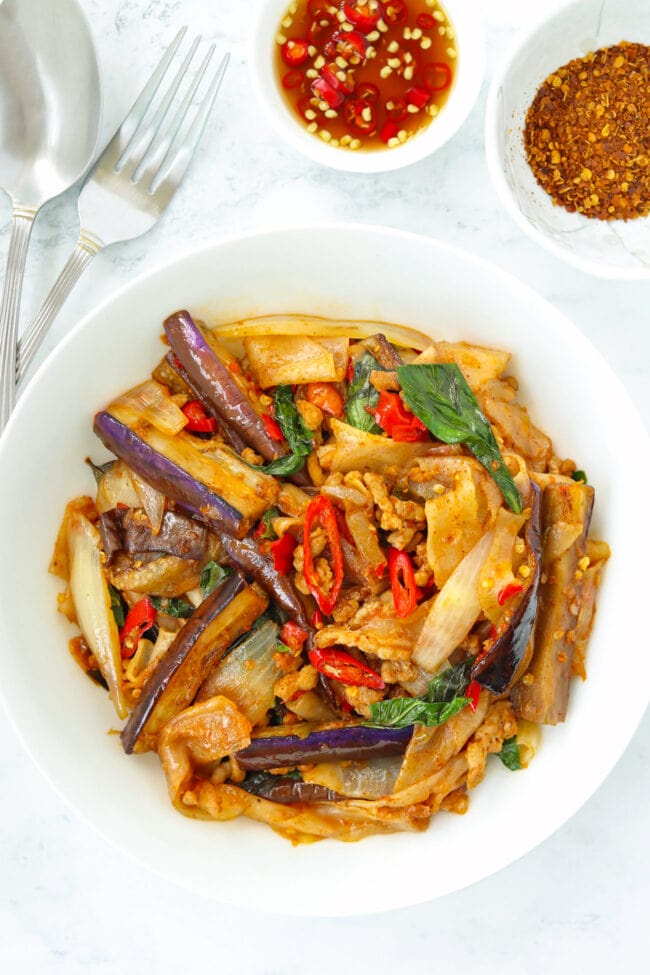
Why This Recipe Works
- Quick and easy! It’s ready from start to finish in 30 minutes and all you need is one wok or pan!
- Dry-frying technique requires less oil. Dry-frying the eggplant strips in a small amount of oil enables them to become tender without having to shallow or deep-fry them.
- EXPLODING with BIG and BOLD flavors! Thai chili paste (nam prik pao), tamarind paste, fish sauce and oyster sauce come together to create a mouthwatering savory-sweet, tangy, and spicy sauce to coat everything.
- Fragrant. Thai sweet basil infuses the noodles stir-fry with fragrant sweet aromas and an anise-y herbal flavor.
- Customizable protein. You can swap the ground pork for other ground meat and make it vegetarian/vegan and gluten-free if needed.
Ingredient Notes and Substitutes
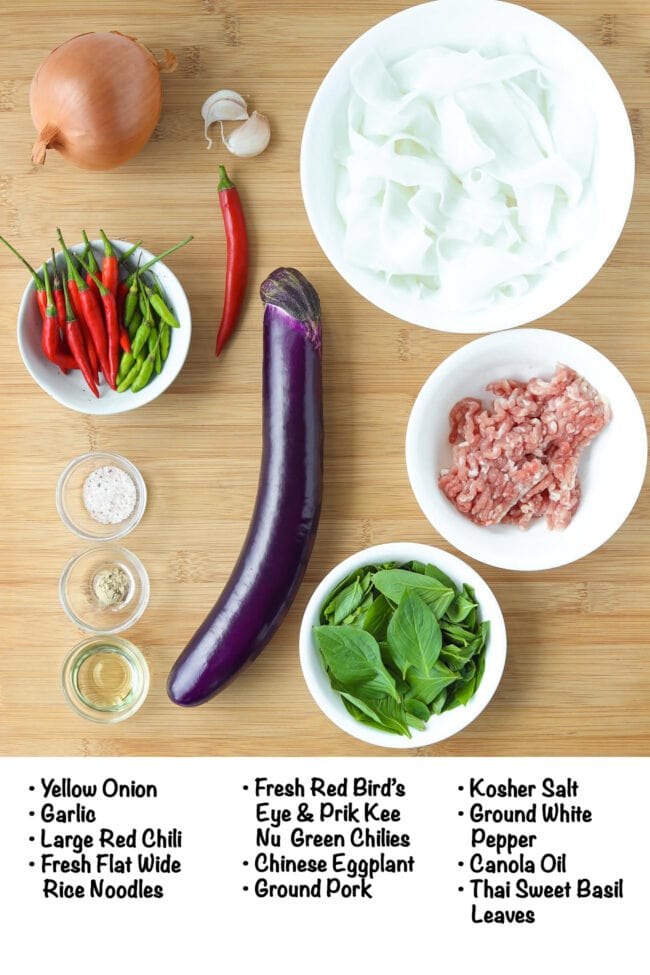
- Fresh Flat Wide Rice Noodles: Fresh rice noodles have a lovely chewy and bouncy texture. They are made from rice flour, water, tapioca or corn starch and salt and are gluten-free. Look for them in the refrigerator section of an Asian supermarket or specialty noodles store. They are available in the form of noodle sheets, which you can cut into noodle strands at home yourself (like I did here). Or you can purchase the pre-cut variety like the noodles I’ve used in my chicken chow fun. If you can’t find them, you can try making your own fresh flat wide rice noodles at home. (If you can’t find them and need to substitute with dried wide rice noodles, see the ‘Notes’ section in the recipe card below for tips on preparation.)
- Chinese Eggplant: Or you could also use a Japanese eggplant instead. In contrast to western eggplants, Chinese eggplants are long and slim and not oblong shaped. They have shiny dark purple skin and white flesh. Due to having less seeds, they are sweet and mild in flavor, not bitter. Look for them in an Asian supermarket or at grocery chops in your local Chinatown. If you’re based in Asia, they’ll be available in your local wet market or supermarket.
- Fresh Chilies: I used a combination or Thai red Bird’s Eye chilies, a few fiery HOT Thai ‘prik kee nu’ green chilies, and a large red chili. Any small hot red and green chilies that you can get in your area will work though. Although the prik kee nu chilies are tiny in size, they are very hot. They can also be tricky to find outside of Asia so I’ve listed them as optional. You may also want to leave them out if you are sensitive to heat. Feel free to adjust the quantity of Bird’s Eye and prik kee nu chilies based on your spice level preference. The large red chili is mild and similar in taste to red bell pepper. It’s mainly used for color here. You can omit it if you don’t have it on hand or substitute with sliced red bell pepper.
- Ground Pork: Use lean ground pork to avoid having extra grease in your noodles. If pork is not your thing, you can swap for ground chicken, beef, turkey, etc.
- Thai Sweet Basil Leaves: These fragrant, sweet smelling leaves are known as ‘horapa’ in Thai. They add a wonderful anise-y flavor and sweet aroma to Thai curries and stir-fries. In terms of appearance, the leaves are glossy and smooth and they have purple flowers. Look for them at a specialty Thai ingredients store or Asian supermarket. You can substitute with Thai holy basil (known as spicy basil, ‘kra pow’, ‘gaprao’, or ‘kaprao’ in Thai), which has a peppery and spicy flavor profile. If you can’t get a hold of either, simply use regular Italian basil – these eggplant noodles will still taste great!
- Canola Oil: Or use any neutral flavored cooking oil you like.
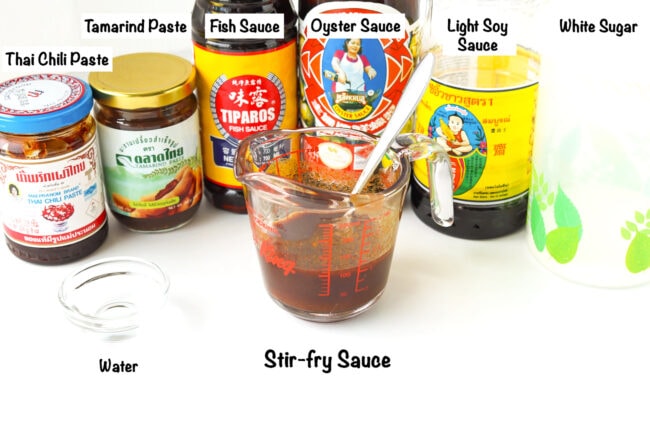
- Thai Chili Paste/Chili Jam (Nam Prik Pao): The umami packed star ingredient in these Thai Eggplant Noodles! It’s also known as “roasted chili paste” or “roasted chili paste in soybean oil”, and ‘nam prik pao’ in Thai. It has a savory-sweet and mildly spicy flavor profile and the texture of jam. While it’s delicious in stir-fries like my Thai Eggplant Stir-fry and rice dishes like Thai roasted chili fried rice and Thai chili jam salmon & rice bake, Thai people love stirring it into soups, using it as a spread for bread, and in sandwiches too. I like to use Mae Pranom brand in my home, which is less sweet than the Pantainorasingh (Pantai) brand Thai chili paste. You can find it in a specialty Thai ingredients store or Asian supermarket, or purchase it online.
- Tamarind Paste: Also known as tamarind concentrate. This is a light brown paste made from tamarind and is sour and sweet in flavor. Some brands are more tangy than others, so you may need to adjust the amount you use accordingly. Make sure you use a Thai tamarind paste and not an Indian one. The latter is black and sticky and not what we need for this recipe. Look for it in the Asian aisle of large supermarkets that are well-stocked with international ingredients or Thai or Asian grocery stores. It’s also available to purchase online.
- Oyster Sauce: Contrary to what one might think, oyster sauce does not taste strongly of oysters. It’s a thick and sticky brownish-black sauce with savory-sweet flavors. It adds rich umami notes to various Asian dishes including these noodles.
Full ingredient list and amounts are in the recipe card below.
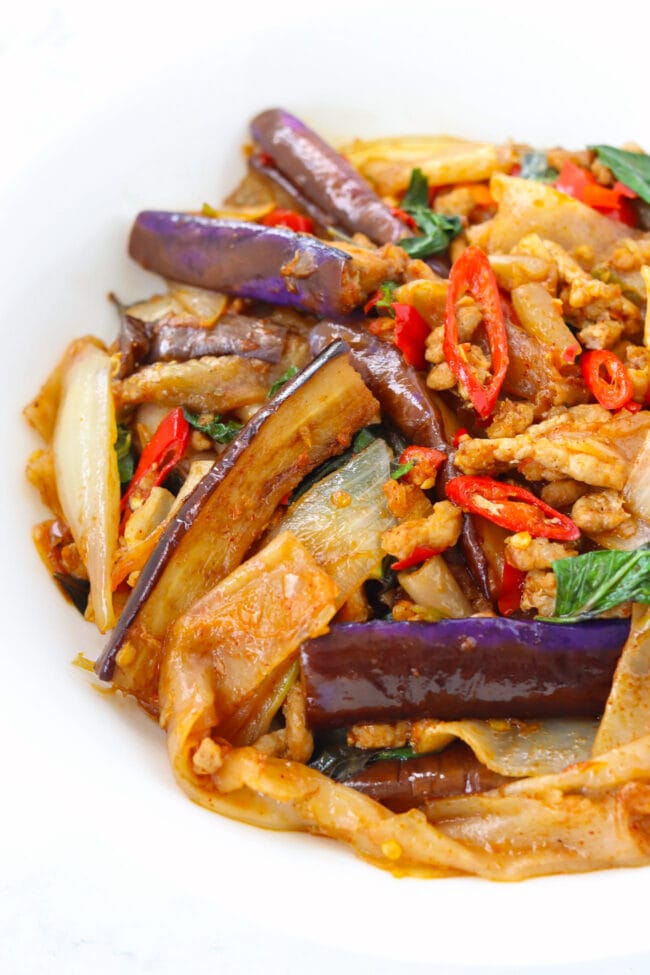
How to Make Thai Eggplant Noodles
Prepare all the ingredients:
1. Slice the eggplant into strips. Place in bowl filled with lightly salted water and allow to soak while you prepare the rest of the fresh ingredients. (Soaking the eggplant in salted water not only will slow down the browning process of the white flesh, it will also make them less prone to absorbing all the oil like sponges when we dry-fry them.)
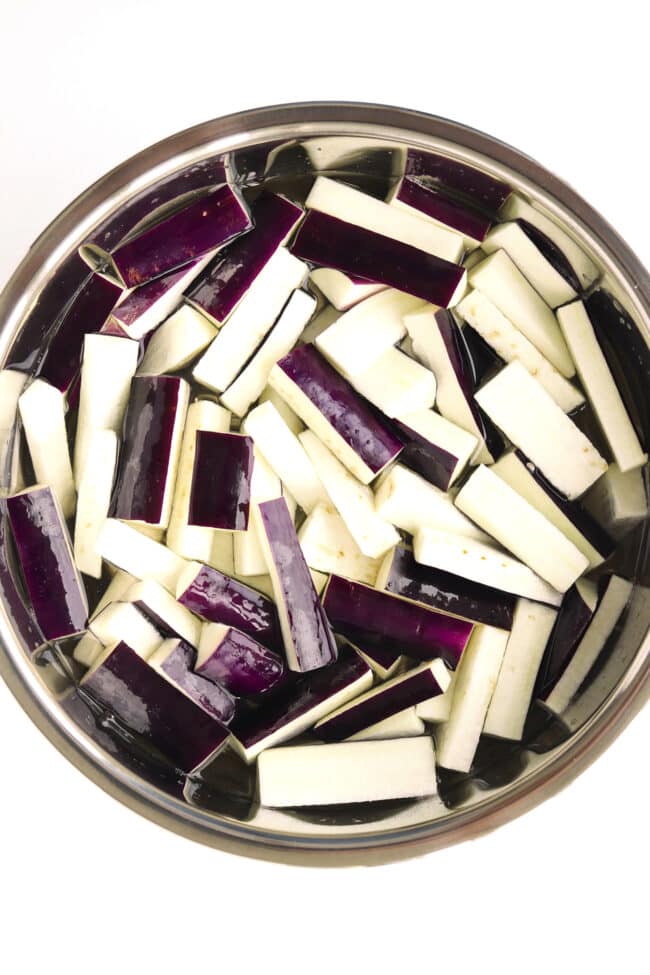
Roughly chop the garlic, Bird’s Eye chilies and prik kee nu green chilies. Use a mortar and pestle to pound into a coarse paste. If you don’t own a mortar and pestle, finely chop them instead.
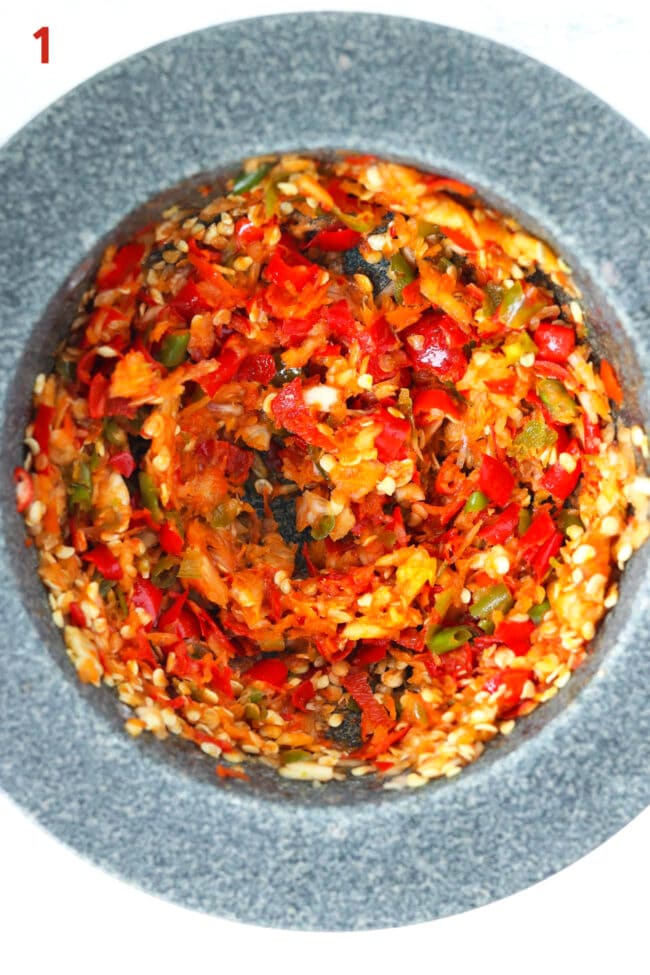
Mix all the sauce ingredients in a measuring cup (for easier pouring) and set everything aside.
2. Dry-fry the eggplant. Heat a little oil in a large wok. Add the eggplant strips and cook for a few minutes, tossing occasionally, until lightly brown and tender. Transfer to a bowl and set aside. (The eggplant strips may not appear to be completely tender at this point. However, the residual heat in the bowl will continue cooking them and they will become tender while they sit in the bowl.)
3. Stir-fry the aromatics. Heat the remaining oil in the wok. Add the onion and stir-fry until slightly softened. Then add the smashed garlic and chilies paste and the large red chili slices. Stir-fry until fragrant.
4. Add the pork. Season with a little ground white pepper and cook for a few minutes, breaking the clumps with your spatula, until just cooked.
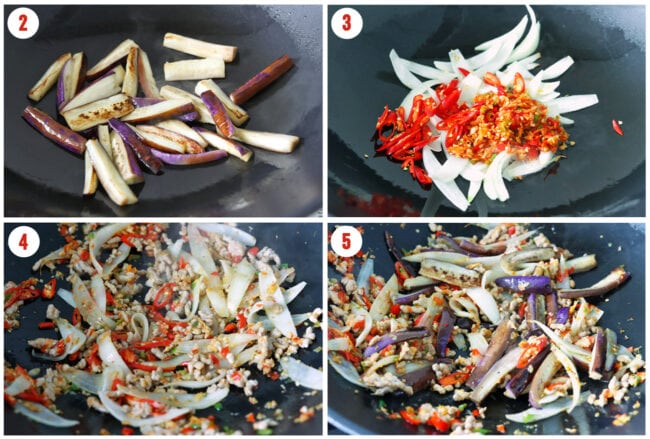
5. Add the noodles and sauce. Toss continuously until everything is evenly coated in the sauce.
6. Season and toss through basil. Season with the remaining ground white pepper and add the Thai sweet basil leaves. Toss briefly to combine until the basil has slightly wilted.
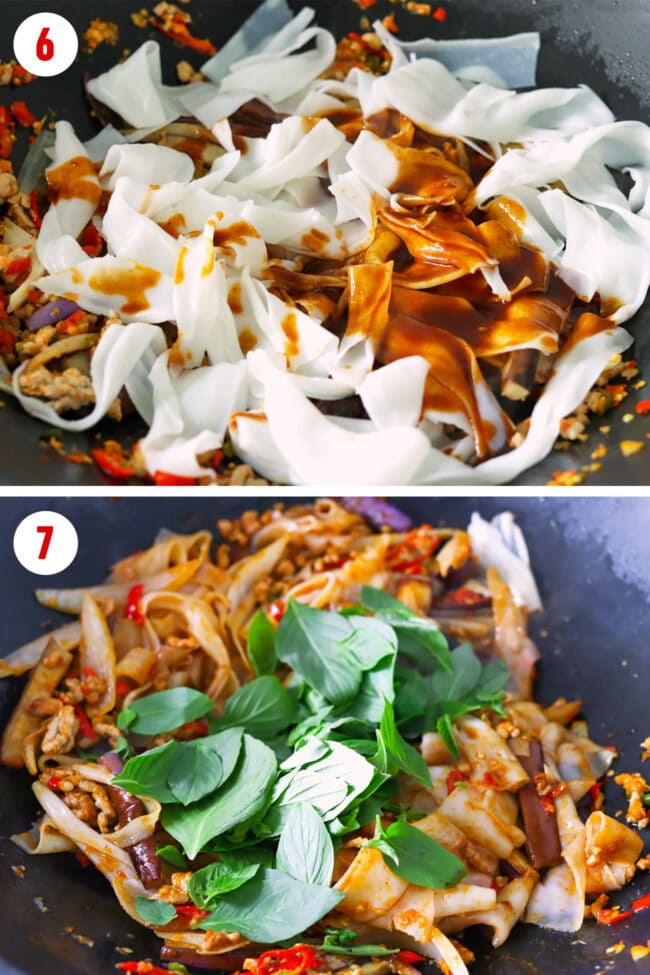
Serve! Divide evenly onto plates and serve immediately while hot. You can also serve Thai chili powder and fish sauce with chopped chilies on the side if desired.
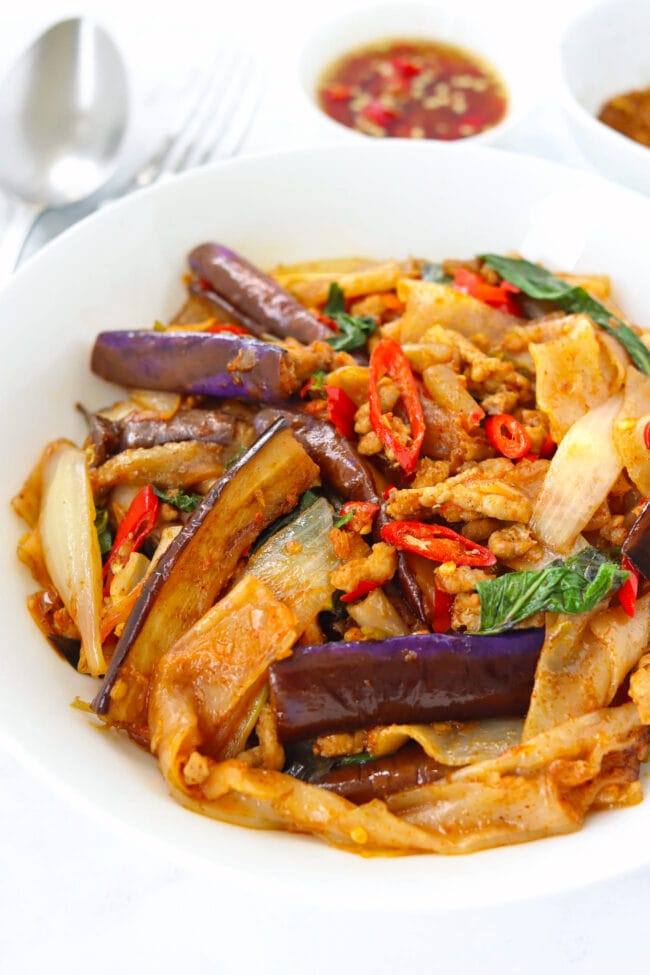
Full detailed instructions are in the recipe card below.
Cook’s Tips
- Prepare all the ingredients before you start cooking. Stir-fries, including this noodle stir-fry go by FAST! Have everything prepped and ready to go before you start cooking.
- Avoid adding too much oil from the Thai chili paste jar. Try to spoon out mostly the paste and less of the red oil on the surface. This will prevent the noodles from becoming too greasy.
- Wear onion goggles (or sunglasses) when using the mortar and pestle to pound the aromatics. Sometimes, small chili seeds can jump out and may hit your eye. Wear protective eye gear especially if pounding a lot of chilies into a paste. You may also want to wear disposable gloves when roughly chopping the chilies to protect your skin.
- Adjust spice level to taste. Use less or more chilies to suit your heat level preference.
FAQs
Chinese eggplants have a mild sweet flavor once cooked. They are not bitter like the oblong shaped eggplants that you can find in the supermarkets in the US or Europe. This is because they have less seeds.
Unfortunately, there isn’t a great substitute that replicates the unique flavors of Thai chili paste/jam, However, you can try making your own Thai chili paste using one of the various recipes online if you can’t get a hold of a store-bought Thai chili paste jar.
Tamarind paste can be used it stir-fries, curries, salads, and more in Thai cuisine. It adds a rich sour and sweet flavor to Thai dishes like Thai eggplant stir-fry, Thai chili jam salmon & rice bake, Thai roasted chili fried rice and pad thai.
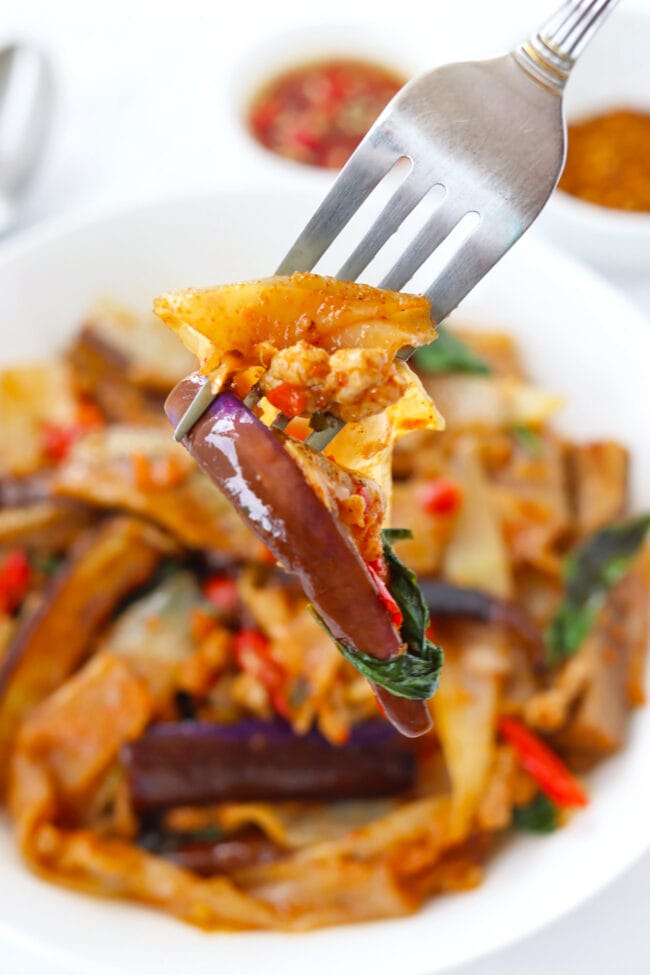
Variations
- Use other ground meat. If you’re not a fan of pork, you can swap for ground chicken, beef, turkey, etc.
- Make it gluten-free. Use gluten-free soy sauce and oyster sauce. Double check the ingredients label of your fish sauce and Thai chili paste to ensure that they are GF certified. (Both normally are, but it’s best to check if you’re cooking for anyone with gluten sensitivities.)
- Make it vegetarian/vegan. Crumbled firm tofu or a plant-based meat substitute such as OmniPork, Beyond Beef®, Impossible™ Beef, Quorn™ Mince, etc. can replace the pork. Use a vegetarian mushroom flavored oyster sauce and more soy sauce in place of the fish sauce. Vegetarian/vegan recipes for Thai chili paste/nam prik pao can be found online and made to use in this Thai eggplant noodles. You can also check if your local Thai groceries store or Asian supermarket stocks Mae Pranom vegetarian Thai chili paste.
More Thai Noodles Recipes
- Spicy Pork Pad Thai
- Pad Mee Korat (Pad Thai’s spicier cousin)
- Pad Kee Mao Gai (Drunken Noodles with Chicken)
- Pork & Tomato Gravy Noodles
- Rad Na Gai (Gravy Noodles with Chicken)
- Pad See Ew
- Or browse the entire Thai Noodles and Noodles recipes collections.
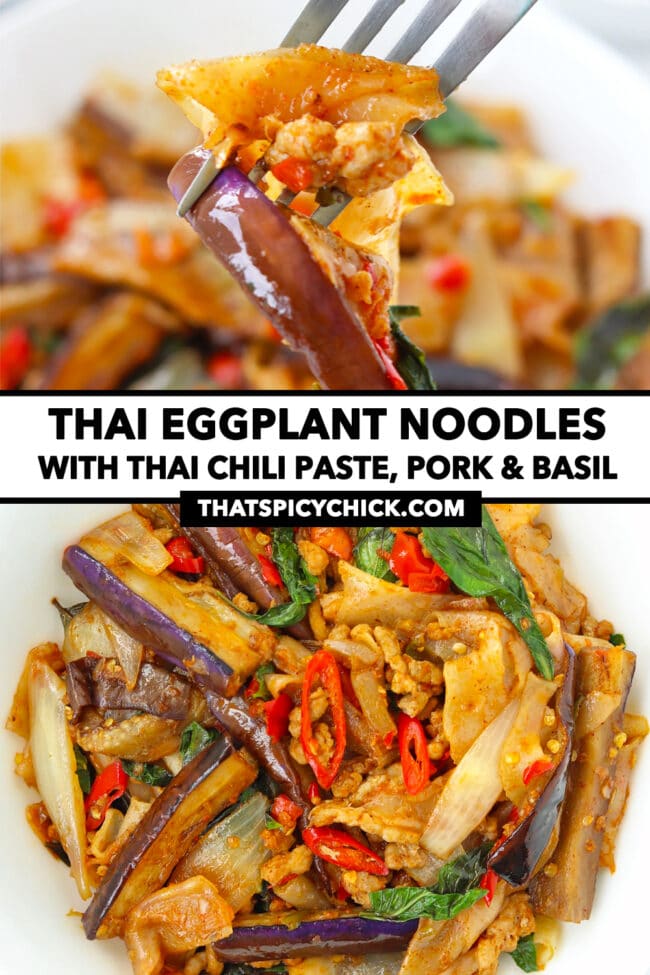
MADE THIS RECIPE? If you make this recipe, leave a comment below and let me know how you liked it! Take a photo and tag it with @thatspicychick on Instagram and hashtag it #thatspicychick and I’ll be sure to share your masterpiece!
STAY CONNECTED! You can also follow me on Pinterest, Facebook or Instagram. Sign up for my email list to get my latest recipe in your inbox weekly!
PrintThai Eggplant Noodles (with Chili Paste, Pork & Basil)
Juicy eggplant strips, ground pork, garlic, chilies, and fragrant Thai sweet basil get tossed with fresh flat wide rice noodles in a mouthwatering sauce in this 30 minute Thai Eggplant Noodles!
- Prep Time: 15
- Cook Time: 15
- Total Time: 30 minutes
- Yield: 2 1x
- Category: Dinner
- Method: Stir-fry
- Cuisine: Thai
Ingredients
For the Sauce:
- 2 TBLS Thai Chili Paste/Chili Jam (Nam Prik Pao – note 1)
- 1 TBLS Oyster Sauce
- 1 TBLS Light Soy Sauce
- 1 TBLS Fish Sauce
- 1 TBLS Tamarind Paste (note 2)
- ½ TSP White Sugar
- 1 TBLS Water
For the Thai Eggplant Noodles:
- 350 grams / 12.35 ounces fresh Flat Wide Rice Noodles (note 3) – cut into 1-inch strips if using noodle sheets and not pre-sliced noodles
- 200 grams / 7 ounces Chinese or Japanese Eggplant – cut into 2-inch long and ¾-inch wide batons
- 1 TSP Kosher Salt
- 1 cup Thai Sweet Basil Leaves (note 4)
- 6 Garlic cloves – roughly chopped
- 2 – 10 fresh Red Chilies (Thai Bird’s Eye or any small hot red chilies – note 5), to taste – destemmed, roughly chopped
- 2 – 6 Prik Kee Nu Green Chilies (optional), to taste – destemmed, roughly chopped
- 1 Large Red Chili – deseeded if desired, thinly sliced at an angle
- ½ medium Yellow Onion – sliced into ¼-inch wide strips
- 3.5 TBLS Canola Oil (or other neutral oil with a high smoke point)
- 150 grams / 5.3 ounces lean Ground Pork
- ½ TSP ground White Pepper, divided
- To Serve (optional): Thai chili powder, fish sauce with chopped chilies (Prik Nam Pla)
Instructions
Prep:
- Make the sauce: Whisk together the Thai chili paste, oyster sauce, light soy sauce, fish sauce, tamarind paste, white sugar and water in a measuring cup (or small bowl) until combined well and set aside.
- Prepare the fresh wide rice noodles: If using sheets of fresh wide rice noodles that are not already pre-cut, cut or (or gently tear) into 1-inch wide strips. If they have been previously refrigerated, remove from the fridge 20-30 minutes (or warm for 20 seconds in microwave on high) before cutting/tearing.
- Prepare the fresh ingredients: Fill a medium bowl with water and stir in 1 TSP kosher salt. Slice the eggplant into 2-inch long and ¾-inch wide batons and transfer to the bowl. Allow to soak for 15-20 minutes. Pick the Thai sweet basil leaves off the stems and wash and pat-dry. Chop/slice the garlic, red chilies, prik kee nu green chilies (if using), large red chili, yellow onion as indicated in the ‘ingredients’ section. Using a mortar and pestle, pound the garlic, fresh Bird’s Eye red chilies and prik kee nu green chilies into a coarse paste and set aside. (Finely chop if you don’t own a mortar and pestle.) Drain the eggplant strips into a colander and pat-dry.
For the Thai Eggplant Noodles:
- Dry-fry the eggplant: Heat 1.5 tablespoons canola oil in a large wok (or deep heavy bottomed frying pan) over medium-high heat. Once hot, add the eggplant strips and cook for 6-7 minutes, tossing occasionally, until lightly browned and tender. Transfer to a clean bowl and set aside. (Don’t worry if the eggplant strips are not fully tender. The residual heat will allow them to continue cooking and become tender while they sit in the bowl.)
- Stir-fry the onion and aromatics: Heat the remaining 2 tablespoons of oil in the wok over high heat. Once hot, add the onion and stir-fry for 30-40 seconds until slightly softened. Add the smashed garlic and chilies paste and the large red chili slices. Stir-fry for 30 seconds until fragrant.
- Cook the pork: Add the ground pork and season with ¼ teaspoon ground white pepper. Cook for 1-2 minutes, breaking the clumps with your spatula, until no longer pink and just cooked.
- Add the noodles and sauce: Add the rice noodles and pour the sauce on top. Toss continuously until everything is evenly coated in the sauce.
- Season and toss through basil: Season with the remaining ¼ teaspoon ground white pepper and add the Thai sweet basil leaves. Toss for 15-20 seconds or until the basil has slightly wilted, then switch off the heat.
- To Serve: Divide evenly onto plates. Serve immediately while hot, with Thai chili powder and fish sauce with chopped chilies on the side if desired.
Notes
- Thai Chili Paste/Jam. This is a savory-sweet paste with the texture of jam. It’s made with soybean oil, dried shrimp, onion, garlic, dried chilies, tamarind, sugar, salt, and shrimp paste. Everything is blended together and then roasted in a pan before being packaged in small jars. It is also known as “roasted chili paste” or “roasted chili paste in soybean oil”, and ‘nam prik pao’ in Thai. Look for a jar in a Thai grocery store or Asian supermarket, or purchase it online. Avoid using too much of the oil in the jar and mainly use the paste to prevent the noodles from becoming too greasy. I recommend Mae Pranom brand, which is less sweet than Pantainorasingh (Pantai) brand Thai chili paste.
- Tamarind Paste. This is also called tamarind concentrate sometimes. It is a light brown paste made from tamarind and is sour and sweet in flavor. Some brands are more tangy than others, so you may need to adjust the amount you use accordingly. Make sure you use a Thai tamarind paste and not an Indian one. The latter is black and sticky and not what we need for this recipe. Look for it in the Asian aisle of large supermarkets that are well-stocked with international ingredients or in a Thai or Asian grocery stores. It is also available online.
- Flat Wide Rice Noodles. Fresh rice noodles have a lovely chewy and bouncy texture. They are made from rice flour, water, tapioca or corn starch and salt and are gluten-free. Look for them in the refrigerator section of an Asian supermarket or specialty noodles store. If substituting with dried wide rice noodles, prepare 150 grams / 5.3 ounces of noodles according to package instructions. Toss them with a bit of oil after draining to prevent them from sticking. Then use as indicated for this recipe.
- Thai Sweet Basil. These fragrant, sweet smelling leaves are known as ‘horapa’ in Thai. They add a wonderful anise-y flavor and sweet aroma to Thai curries and stir-fries. In terms of appearance, the leaves are glossy and smooth and they have purple flowers. Look for them at a specialty Thai ingredients store or Asian supermarket. Substitute with Thai holy basil or Italian basil if unavailable.
- Fresh Chilies. Any small hot red and green chilies that you can get in your area will work if you can’t get a hold of Thai Bird’s Eye and prik kee nu green chilies. Although the prik kee nu chilies are tiny in size, they are very hot. They can also be tricky to find outside of Asia so I’ve listed them as optional. You may also want to leave them out if you are sensitive to heat. Adjust the quantity of Bird’s Eye and prik kee nu chilies based on your spice level preference. The large red chili is mild and similar in taste to red bell pepper. It’s mainly used for color here. Omit it if you don’t have it on hand or substitute with sliced red bell pepper.
- See ‘Variations’ section in the post above to customize for specific diets.
Nutrition
- Serving Size: 1 serving
- Calories: 844
- Sugar: 26.6g
- Sodium: 1614.2mg
- Fat: 42.2g
- Saturated Fat: 10g
- Unsaturated Fat: 29.7g
- Trans Fat: 0.2g
- Carbohydrates: 95.8g
- Fiber: 7.8g
- Protein: 26.1g
- Cholesterol: 55.4mg
This post may contain affiliate links. We are a part of the Amazon Services LLC Associates Program, an affiliate advertising program designed to provide a means for us to earn a small commission (at no extra cost to you) by linking to Amazon.com and affiliated sites. The nutritional information provided is approximate and can vary based on several factors. It should only be used as a general guideline. For more information, please see our Disclosure.

